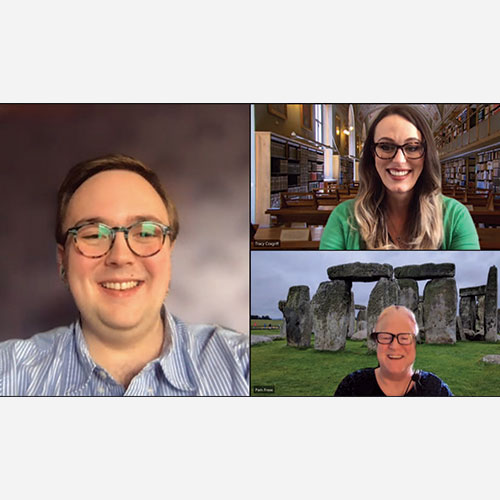
Perceiving artifacts from multiple lenses enhances meaning

For students with multiple majors like Jonas Short, Independent Study can act as an opportunity to combine multiple interests in a project they’re truly passionate about. Short’s combination of anthropology and art history isn’t a “violent collision,” as he shared, he’d joked about with mentors Pam Frese, professor of anthropology, and Tracy Cosgriff, assistant professor of art and art history, middle eastern, and North African studies.
“There’s not a competition between these approaches but fusing them together in a single project is really fascinating and exciting, because it can give you even deeper and more meaningful information than either on its own,” Short said. He found working closely with Frese and Cosgriff to be an “amazing experience in doing this kind of deep, meaningful research as an undergraduate.”
For them, being a part of an interdisciplinary I.S. has allowed them to learn from Short as well as each other. “Double majors instruct both faculty, as well as the student,” Frese said. “Every discipline that we put in different buildings on campus intersects with the others, and with a double major, students learn from two different faculty perspectives on the discipline, but the student develops something brand new that neither of us thought about or did before.”
With an interest in studying the printed image and how it impacts culture, Short’s I.S. research primarily looked at a turquoise and feather shield and a golden feather helmet originally made in Aztec Mexico that later ended up in Europe in the collection of Margaret of Austria, the aunt of Emperor Charles V. “I’m really interested in the intersection of cultures and how ideas about the world translate from one to another,” he said, explaining that he translated the inventory of the objects from Middle French to English. “I looked at what these two objects can tell us about the wider transition of ideas and ideologies, as Europe was quickly trying to situate two entirely new continents into its understanding of the world.”
While translation, especially in a completely digital environment, is difficult work, Short felt prepared for the research after working with Cosgriff as a research assistant at the end of his junior year. “Even when life throws a curveball, something at Wooster has helped you adapt to it,” he said. His research uncovered an overlap of meanings behind the objects. “By teasing apart their shifting definitions as these examples moved from the Americas to Western Europe, Jonas has revealed a network of meanings typically overlooked by both anthropology and art history,” Cosgriff explained. The helmet, for example, was “a symbol of creation, but also a symbol of destruction and the end of days” within Mesoamerican culture, and in the European collection, Short explained, “it becomes a devil or a demon, even though there was no such thing as a devil or demon in Aztec contexts.”
Understanding how different cultures impact the meaning of objects is an idea Frese constantly encouraged Short to think about as he reviewed information from his sources. “She would ask questions like, ‘Why would the priest want it to mean that?’” He said. “It forced me to consider these objects much more critically and sensitively.” Thinking critically in this way is a skill Short sees himself using as a museum curator, a field of graduate study he’s interested in: “It’s really critical to examine why we define art objects and artifacts the way we do, and in relation to whose definitions, whose culture, and whose experience.”
His interest in museum studies helped Cosgriff and Frese to guide Short in his research as he began work on his I.S. early in the year. “I encourage students to frame an I.S. along the lines of what their passions are, as well as where they would like to see themselves down the line,” said Frese. “We then craft an I.S. that can open paths for them.”
As he applied to graduate school, Short found that faculty in the programs took interest in hearing about his research. He plans to attend the University of Southern California’s Roski School of Art and Design to study his master’s in cultural practices and the public sphere in the fall. “This is not the senior year I thought I’d be having, but I wouldn’t trade it for the world,” he said. “I’ve done work that I’m really proud of and that I’m excited to share as I graduate and move on to graduate studies.
Originally published in the summer 2021 issue of Wooster magazine.
Posted in Independent Study on July 7, 2021.
Related Posts
Related Areas of Study
Art - Art History
Explore the cultural and historic significance of art and artists while building research and analytical skills.
Major MinorAnthropology
Use problem-solving and research skills to explore and understand communities and cultures in every part of the world.
Major Minor

